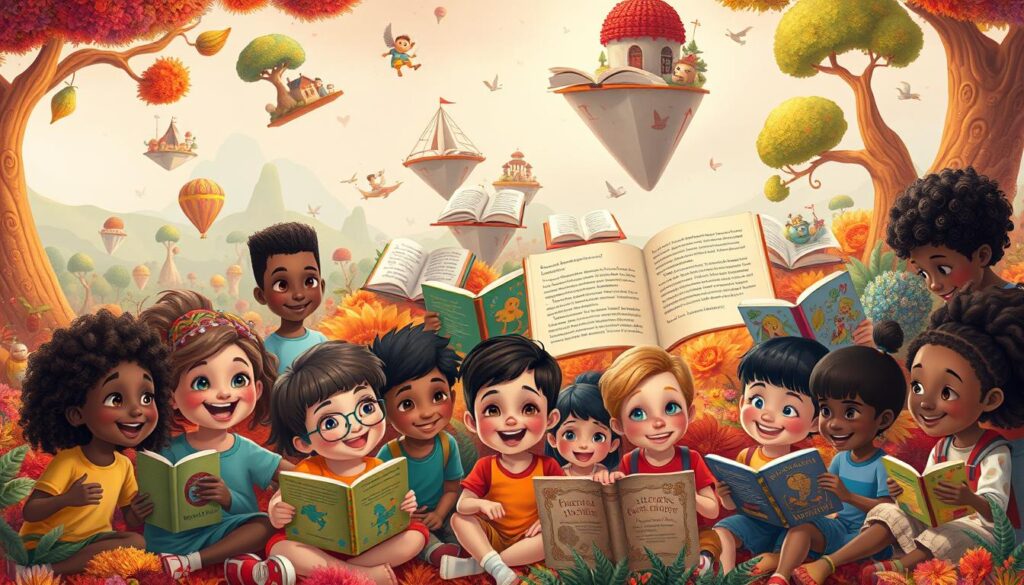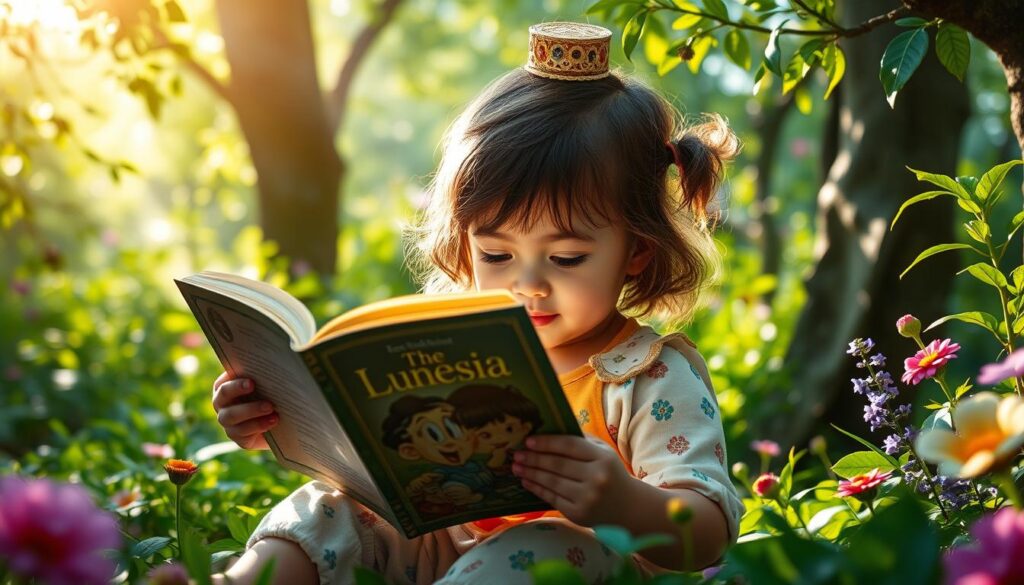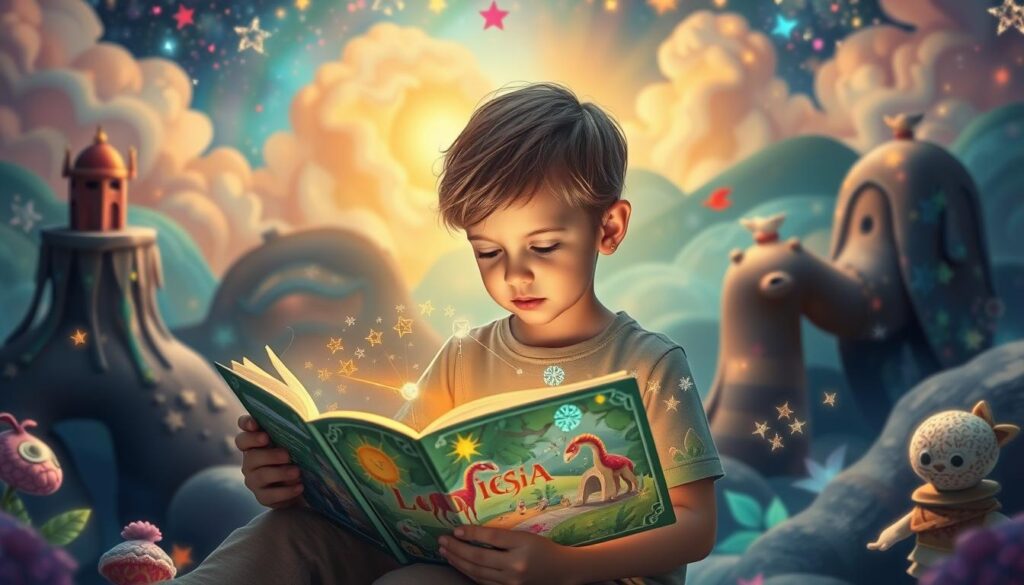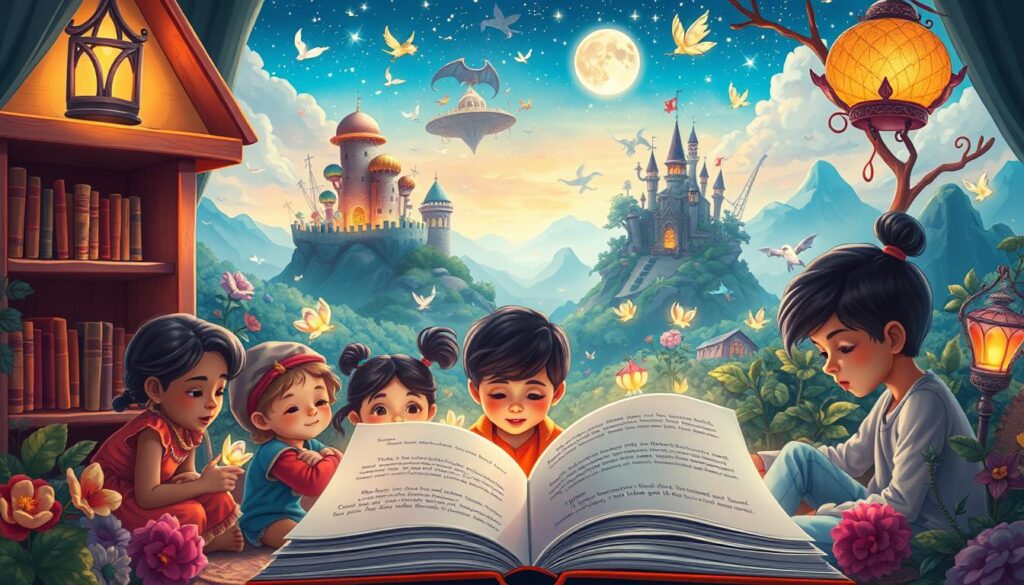Are you searching for stories that not only captivate your child’s imagination but also foster a love for learning?
As a parent and educator, I’ve witnessed firsthand how Lunesia books can transport children to magical worlds while teaching valuable lessons.
These aren’t just any stories; they’re carefully crafted to introduce important concepts and values, making them a favorite among kids and parents alike.
In this article, I’ll explore the top 10 educational themes found in these beloved books, showing you how they can make learning a joyful adventure.
By the end, you’ll understand why these stories have become a staple for readers of all ages.
Why Educational Themes Matter in Children’s Stories
As a parent, I’ve come to realize that the stories we share with our children are more than just entertainment – they’re a gateway to learning and growth. Educational themes in children’s stories play a vital role in shaping young minds.
The Power of Storytelling in Child Development
Storytelling has been a cornerstone of child development across cultures for centuries. It helps children process complex ideas, emotions, and values, making it an invaluable tool for learning. By engaging with stories, children develop empathy, curiosity, and critical thinking skills.
How Lunesia Stories Blend Education with Entertainment
Lunesia stories expertly combine education and entertainment, making learning feel like an adventure. The characters in these stories face challenges and make discoveries that mirror the developmental journeys of the children reading them, creating emotional connections that enhance retention and comprehension. By choosing stories with intentional educational themes, parents can provide their children with both entertainment and valuable life lessons.
Diverse Narratives and Representation
The world of children’s literature is undergoing a significant transformation, embracing diverse narratives that reflect the complexity of our global society. As a result, the stories we share with our children are becoming more inclusive, featuring characters from various backgrounds and cultures.
This shift is crucial in helping children develop empathy and understanding. By seeing themselves and others in the stories, children can build a more nuanced view of the world.

Cultural Diversity in Lunesia Stories
Lunesia stories showcase a wide range of cultural diversity, featuring protagonists from different cultural backgrounds who maintain their authentic identities while embarking on universal adventures. These narratives thoughtfully incorporate cultural elements, such as celebrations, food, and family structures, without resorting to stereotypes.
- Characters from diverse backgrounds play central roles in the stories.
- Cultural elements are woven into the narratives to create an authentic experience.
- These stories help children appreciate the differences and similarities between themselves and others.
How Representation Builds Empathy in Young Readers
When children see characters who look like them in stories, it validates their experiences and builds self-confidence. Equally important, when they encounter characters different from themselves, they develop curiosity about and respect for other cultures.
Research shows that exposure to diverse characters in stories helps children develop greater empathy and reduces prejudice from an early age. By reading about diverse experiences, children can gain a deeper understanding of the world around them.
Environmental Awareness and Sustainability

As we navigate the complexities of environmental challenges, it’s heartening to see how Lunesia stories are inspiring young minds to take action. Eco-conscious themes are becoming a cornerstone of modern literature for young readers. These stories not only entertain but also educate, fostering a sense of responsibility and awareness in children.
Eco-Conscious Storylines in Lunesia
Lunesia stories weave environmental themes into magical adventures that captivate children while nurturing their connection to the natural world. These storylines introduce concepts like conservation, renewable energy, and biodiversity in ways that children can understand and relate to.
- I love how Lunesia stories introduce concepts like conservation, renewable energy, and biodiversity in ways that children can understand and relate to.
- Rather than presenting environmental issues as overwhelming problems, Lunesia stories empower children by showing characters taking meaningful action.
- The magical elements in these stories often serve as metaphors for real environmental processes, making complex concepts accessible.
How Environmental Themes Foster Responsibility
These environmental storylines foster a sense of stewardship and responsibility that extends beyond the pages into children’s everyday choices. Parents report that after reading Lunesia stories, their kids become more conscious of waste, energy use, and their impact on the environment.
- Children learn about the interconnectedness of ecosystems through characters who discover how their actions affect the magical world around them.
- The books often include practical ideas that families can implement together, from starting a garden to reducing plastic use.
- By presenting environmental care as a normal part of daily life rather than an exceptional behavior, these stories help normalize sustainability for children.
Author Kris Herbert shares: “Kids who read eco-stories start 83% more school green initiatives.” This highlights the real-world impact of these experiences, showing that Lunesia stories are not just entertaining but also educational, promoting environmental awareness and inspiring the next generation to take action.
Emotional Intelligence and Mental Health

As we explore the world of Lunesia stories, it’s clear that emotional intelligence and mental health are becoming increasingly important themes. I’ve noticed how these stories are helping kids navigate their emotions and build resilience. From anxiety to mindfulness, authors are crafting narratives that address real-life challenges in ways that resonate with children.
Child therapist Dr. Amara Singh explains: “Stories give kids language for big feelings.” This is why initiatives like Scholastic’s mental health content advisory board are so important. They ensure that books are both engaging and supportive. For more information on how Lunesia stories are making a positive impact, you can check out the review on Lunesia App Review.
Managing Anxiety Through Magical Adventures
Lunesia stories provide children with a safe space to explore complex emotions through characters they can relate to and care about. The magical adventures in Lunesia often serve as metaphors for emotional challenges, helping children process their feelings in a non-threatening context.
Building Emotional Literacy with Lunesia Characters
Characters in these stories model healthy emotional regulation strategies that children can apply in their own lives. Through these narratives, children develop an emotional vocabulary that helps them identify and express their feelings more effectively. By seeing characters overcome emotional challenges, children develop confidence in their own ability to manage difficult feelings.
Interactive Storytelling and Problem-Solving
As a parent, I’m fascinated by how Lunesia stories incorporate interactive elements that make reading a dynamic adventure. These stories transform children from passive readers into active participants in the narrative.
Engaging Young Minds
Lunesia stories often include decision points where readers must choose what the character should do next, encouraging critical thinking and consequence evaluation. This interactive format helps children understand that their choices matter and that different decisions lead to different outcomes.
- Problem-solving scenarios challenge children to apply logic, creativity, and empathy to help characters overcome obstacles.
- Many Lunesia books include puzzles, codes, or mysteries that readers must solve alongside the characters to advance the storytelling experience.
Enhancing Critical Thinking
The interactive elements in Lunesia stories not only make reading engaging but also enhance problem-solving skills. By actively participating in the story, children develop a deeper connection to the characters and retain more of the educational content.
| Benefits of Interactive Storytelling | Description |
|---|---|
| Critical Thinking | Encourages children to evaluate consequences and make informed decisions. |
| Problem-Solving | Develops persistence and resilience through challenging scenarios. |
| Engagement | Makes reading a dynamic experience, appealing to reluctant readers. |
By incorporating interactive storytelling and problem-solving elements, Lunesia stories provide a comprehensive and engaging reading experience for young readers.
STEM Concepts Made Fun and Accessible

By embedding STEM concepts in magical adventures, Lunesia stories capture children’s imagination like never before. STEM-focused stories are transforming how kids approach science, technology, engineering, and math. As author Maria Gill puts it, “Stories make abstract concepts taste like adventures.”
Science and Math Themes in Lunesia Adventures
Lunesia stories demystify STEM concepts by embedding them in magical adventures. Scientific principles like gravity, states of matter, and simple machines are introduced through characters’ experiences rather than direct instruction. Mathematical concepts such as patterns, measurement, and basic geometry appear naturally within the narrative as characters solve problems.
The magical elements of Lunesia often serve as metaphors for real scientific phenomena, creating memorable mental hooks for complex concepts. By seeing diverse characters excel in STEM-related challenges, these stories help break down stereotypes about who can succeed in these fields.
Technology and Engineering Concepts for Young Minds
The technology and engineering elements in Lunesia stories show innovation as a creative process, encouraging children to become creators rather than just consumers. These narratives present failure as a natural part of the scientific process, teaching children that mistakes are valuable learning opportunities.
Parents report that their children often want to try experiments or building projects inspired by what they’ve read in Lunesia stories. By making STEM concepts accessible and fun, Lunesia stories help build confidence in subjects that might otherwise intimidate some children.
Mindfulness and Self-Regulation
I’ve observed firsthand how the narratives in Lunesia can help children cultivate mindfulness and better manage their emotions. By incorporating calming techniques and promoting self-regulation, these stories provide children with essential life skills.

Lunesia stories skillfully weave mindfulness practices into their narratives, helping children develop self-regulation skills. The characters in these stories often use breathing techniques, visualization, or grounding exercises when facing challenges, normalizing these practices for young readers.
Calming Techniques Embedded in Lunesia Narratives
The narratives in Lunesia are rich with sensory descriptions that guide children into a more mindful state. By engaging with these stories, children can learn valuable techniques to manage their emotions and reactions to difficult situations.
- Characters model healthy emotional regulation, showing children that managing feelings is a skill that can be developed.
- The stories validate children’s emotions while providing concrete tools to navigate those feelings.
- By embedding mindfulness techniques within engaging narratives, Lunesia stories make these practices accessible to young children.
How Stories Help Children Manage Big Emotions
Lunesia stories offer more than just entertainment; they provide children with the tools to understand and manage their emotions. By following the characters’ journeys, children can develop a better understanding of their own emotional landscapes and learn to regulate their feelings in a healthy way.
For more interactive and engaging experiences, you can explore the Lunesia app, which offers a range of stories designed to promote mindfulness and self-regulation in children.
Creative Arts and Self-Expression
Creative expression is a vital part of Lunesia stories, helping children discover their unique voice. These narratives celebrate the arts, encouraging young readers to explore their creativity through various forms of self-expression.
Artistic Themes in Lunesia Narratives
Lunesia stories are rich in artistic themes, featuring characters who use music, art, dance, and storytelling to express themselves. The Fantabulous Animal Orchestra, for example, turns musical physics into a playful lesson, while Wizardry to Wētā Verse uses spellcasting rhymes to explain insect life cycles. These creative narratives make learning fun and accessible.
Fostering Creativity Through Storytelling
By incorporating visual arts and musical elements, Lunesia stories introduce children to concepts like color theory, perspective, and rhythm. The narratives often show characters overcoming creative blocks, teaching children that creativity is about courage and persistence. Parents report that after reading these stories, their children are more likely to initiate their own creative projects.
Educational Themes in Lunesia Stories for Different Age Groups
I’ve observed that Lunesia stories effectively adjust their educational content to suit various age ranges, making them a valuable resource for children’s learning and development.
Lunesia’s approach to tailoring their stories for different age groups is truly commendable. As children progress from one stage to another, the complexity and depth of the educational themes in Lunesia stories evolve accordingly.
Preschool (Ages 3-5): Foundation Building
For preschoolers, Lunesia stories focus on foundational concepts such as colors, shapes, numbers, and basic emotional vocabulary. These early stories use repetition, rhythm, and simple plots to engage young children while introducing fundamental concepts. The characters in these stories model basic social skills like sharing, taking turns, and using kind words.
Early Elementary (Ages 6-8): Skill Development
As children enter early elementary, Lunesia stories incorporate more complex problem-solving and begin introducing academic concepts. These narratives support emerging reading skills with more text, while maintaining engaging illustrations that aid comprehension. The stories for this age group often include simple science concepts, mathematical thinking, and more nuanced emotional situations.
Upper Elementary (Ages 9-11): Complex Concepts
For upper elementary readers, Lunesia stories tackle more complex concepts and ethical dilemmas appropriate for their maturing minds. These stories introduce more sophisticated STEM concepts, historical contexts, and complex character motivations, challenging young readers to think critically and empathetically.
| Age Group | Educational Focus | Story Features |
|---|---|---|
| Preschool (3-5) | Foundation Building | Repetition, rhythm, basic social skills |
| Early Elementary (6-8) | Skill Development | Complex problem-solving, simple science concepts |
| Upper Elementary (9-11) | Complex Concepts | Sophisticated STEM, historical contexts, complex character motivations |
The beauty of Lunesia’s approach lies in their ability to craft stories that can be enjoyed across age groups, with children extracting different levels of meaning as they grow. This adaptability makes Lunesia stories a valuable resource for children’s educational journey.
Conclusion: Bringing Educational Themes to Life at Home
Engaging with Lunesia stories is just the beginning; you can amplify their educational themes by integrating related activities into your child’s daily life at home.
To extend the learning from Lunesia stories, try simple activities that reinforce their educational themes. For instance, after reading stories with environmental themes, take a nature walk with your child to observe and discuss the natural world around you.
For stories focusing on emotional intelligence, create a feelings chart or journal where your child can track and express their emotions. You can also use STEM-themed stories to inspire kitchen science experiments or building projects using materials you already have at home. This not only fosters learning but also makes it fun for your kids.
By thoughtfully selecting Lunesia books that align with your child’s interests and developmental stage, you’re providing them with entertainment that nurtures their growth in countless ways. So, snuggle up with your kids and a good book, and watch their imagination and understanding of the world grow.
As parents, you play a vital role in making learning a joyful experience for your kids. By engaging with Lunesia stories and related activities, you’re not only enhancing their educational themes but also creating lasting memories.
FAQ
How can I help my child relate to the characters in picture books?
You can help your child relate to the characters by pointing out their feelings and actions, and by discussing how they might handle similar situations. This encourages empathy and helps children develop emotional intelligence.
What are some ways to make reading a fun experience for my child?
Make reading a fun experience by creating a cozy reading nook, choosing picture books with engaging illustrations, and reading together with inflection and enthusiasm. You can also ask questions and encourage your child to predict what might happen next in the story.
How can I use historical fiction to teach my child about different time periods?
Historical fiction can be a great way to teach children about different time periods by making the experience more engaging and relatable. You can discuss the historical context and events depicted in the book, and encourage your child to think critically about the past.
What role do illustrations play in children’s books?
Illustrations play a crucial role in children’s books, as they help to bring the story to life and capture a child’s attention. They can also aid in comprehension and encourage children to develop their own interpretation of the narrative.
How can I help my child develop critical thinking skills through reading?
You can help your child develop critical thinking skills by asking open-ended questions about the story, encouraging them to make connections between the narrative and their own life, and discussing the characters’ motivations and actions.
What are some benefits of using storytelling to teach children about different subjects?
Storytelling can make complex subjects more engaging and accessible to children. It can also help to develop their creativity, empathy, and critical thinking skills, while making learning a fun and enjoyable experience.
How can I incorporate math and science concepts into our reading routine?
You can incorporate math and science concepts into your reading routine by choosing books that incorporate these subjects, and by discussing the relevant concepts and ideas with your child. This can help to make learning more engaging and interactive.




